Read more stories about the people who made Central College special in the 1940s. Then scroll down for a photo gallery of the decade.
Joy McCain Crelin ’48
Joy McCain Crelin followed her brother’s footsteps from Closter, N.J. to Central College. Her brother Walter wanted to be a pilot, so he joined the Navy cadets training at Central College. When Crelin graduated, her father asked her if she wanted a car or money for a graduation gift. She replied: “I’d like to go to college.”
And, boy, did she ever make thee most of her four years at Central. An English major, Crelin never let herself rest. She was in the Delphi Society, Student Senate, Intersociety Council, the future teachers club, Alpha Phi Omega and the staffs of the Pelican and the Ray. She was president of the Player’s Guild and a cheerleader; she starred in several plays and ended up as class president for two years. She was also crowned Homecoming Queen and queen of Club Centralia.
Crelin met her husband Ed ’47 at Central. Back in high school, he was the leader of a brass band. But there was no dancing allowed on campus at Central. So Ed worked with President Liggett to set up dances at the Legion Hall downtown. Ed’s orchestra played 1940s hits, Crelin sang and the students danced. “Oh, we had a great time!” she recalls.
Graduating from Central as class president, Crelin was in charge of the class gift. She had a brilliant idea—replace the huge tubs and washboards in the basement of Graham Hall with real washing machines! But the administration rejected the idea. Crelin was livid, though looking back she realizes that the pipes in Graham probably didn’t allow the machines. “I was kind of a troublemaker,” Crelin says with a laugh, “though not in a bad way.”
After graduation, Crelin moved with her husband to New Haven, Conn., where he attended graduate school at Yale. She supported her husband by working at a small company. Later, she taught English.
“It was a wonderful time at Central,” Crelin says of the 1940s. “I have always loved it and never regretted going to Central College.”

Joy’s brother, Walter L. McCain, Jr., trained at Central to be a pilot. He was married to Martha Childress Miller ’48 12 days before he was sent to Europe. In a heroic act, Walter was killed when his plane was shot down over Germany. Walter’s crew came to pay their respects to the family after the war.
Wilma Damhof Hoekstra ’45
 In rural Minnesota in the 1930s, not many girls finished high school. But if you did, and you were part of the Reformed Church in America, your name was automatically sent to Central College. When Wilma Damhof Hoekstra ’45 graduated from high school, a dean and a few professors came up to encourage her to attend. Buoyed by her sister’s success at Central the previous year, Hoekstra agreed.
In rural Minnesota in the 1930s, not many girls finished high school. But if you did, and you were part of the Reformed Church in America, your name was automatically sent to Central College. When Wilma Damhof Hoekstra ’45 graduated from high school, a dean and a few professors came up to encourage her to attend. Buoyed by her sister’s success at Central the previous year, Hoekstra agreed.
Hoekstra and her sister sat crammed in the backseat of an upperclassmen’s car as they made their way back and forth to Pella. On campus, they shared a room in Graham Hall and joined the literary society Alpha Kappa Alpha. They also participated in Gospel Team, where the men in pre-ministerial studies would go to outlying churches without pastors and preach on Sundays. Hoekstra and her sister taught Sunday school and provided music. The friendships she made with those future ministers lasted her whole lifetime.
“I really felt that was answering the yearn I had in my heart to do something for the Lord,” she says.
After a year at Central, Hoekstra’s boyfriend Tony came to join her. They had an idyllic year on campus together before he left to join the Navy and serve in World War II. They would walk around town and admire the parks and houses. On special evenings, they would go to the tiny movie theater downtown and then have ice cream sundaes at Central Park Café. It all cost less than a dollar. Hoekstra knew she had chosen well when Tony bought her the pretty and expensive pin for her AKA. “For my birthday that fall, he bought one for me,” says Hoekstra. “I knew then that I had the right partner.”
Before Tony left for the service at the end of the year, he put a diamond ring on her finger. Having completed the two years in education she needed for her teaching certificate at the time, Hoekstra returned home to care for her younger brother and disabled sister. She and Tony married a year and a half later, and she had their first son, Donald, while he was still serving overseas.
Years later, the Hoekstras returned to Pella. Tony went back to Central to finish his degree, and then she followed, finishing her last two years. During that time, she shared an English class with Donald ’67, one of her many children to attend Central College.
Hoekstra spent 20 years teaching at Lincoln High School. Since she earned her bachelor’s at Central, 22 of her children and grandchildren and their spouses have become Central College alumni. The Hoekstras followed their grandchildren through their music and athletics events, returning to campus for family and friendship.
“Those are the things you don’t buy,” she says. “That’s our legacy, and Central has been a big part of that.”
Betty Brands Huitsing ’49
 Betty Brands Huitsing ’49 grew up in Morrison, Ill., and chose Central College because it was affiliated with the Reformed Church in America. She majored in history and met her favorite professor, Dr. Laura Nanes, who was almost universally beloved on campus. “She really knew her history, and she made it very interesting,” says Huitsing. “It was because of her that I majored in history and minored in education.”
Betty Brands Huitsing ’49 grew up in Morrison, Ill., and chose Central College because it was affiliated with the Reformed Church in America. She majored in history and met her favorite professor, Dr. Laura Nanes, who was almost universally beloved on campus. “She really knew her history, and she made it very interesting,” says Huitsing. “It was because of her that I majored in history and minored in education.”
After class, Huitsing was active on campus in many organizations. She was a Delta Phi, played the oboe in the orchestra and took piano and organ lessons. She was also part of YWCA (Young Women’s Christian Association), which held basketball, volleyball, soccer and chess competitions.
With a roommate as a P.E. major, Huitsing took on an unusual job refereeing with her friend at Iowa high school basketball games, where the girls played six on a team and covered only half the court.
Campus life, though not exactly luxurious, was still fun for Huitsing and her friends. “We couldn’t call for pizza yet, and we didn’t have TVs or ovens,” she recalls. Instead, they held pajama parties and dorm meetings. When a call came in, the phone at the front desk sounded her own personal ring, and Huitsing would have to run down to catch it in time. By the time she graduated, phones were installed at the end of each hallway in Graham, a major improvement in privacy.
By graduation, a lot had changed on campus. The veterans returned, and their life experience and work ethic improved her classes, Huitsing says. But vestiges of the war were still apparent. The draft was on, and freshmen would head off to service just as the older men were returning. Rationing was also still in place, and students had to turn in ration coupons for sugar and wheat. If you didn’t—and many households keenly felt the loss of one person’s stamps—you had to sit at a special table in the dining hall that didn’t serve sugar. “It was a really serious time, and so we had to look for fun and forget about all that,” says Huitsing. “Of course, we were happy that people were returning and that the war was over.”
Finding fun was easy with so many social events to attend. Huitsing had several long, formal dresses for dances, such as Sadie Hawkins, where the women asked the men for dates. For class, however, the women wore skirts, sweaters and booby socks. Pants were acceptable on weekends. Like any decade, fashions began to change, and Huitsing had to trade in her knee-length skirts for the longer skirts coming into style.
With all the good memories from her time at Central, Huitsing is most appreciative of her professors and the interest they took in their students’ lives. “They all wanted you to do well and end up with a good education,” she says. Huitsing did, and she went on to become a teacher for 25 years.
Artis Vande Voort Leabo ’48
 Artis grew up in Pella, so it was a natural choice for her to attend Central. What wasn’t natural—at least at the time—was earning a degree in business, rare among women in the 1940s.
Artis grew up in Pella, so it was a natural choice for her to attend Central. What wasn’t natural—at least at the time—was earning a degree in business, rare among women in the 1940s.
Leabo recalls the compulsory chapel every day and the rotating assigned seating in the dining hall, where the Dean of Women, Mrs. Prins, held sway. “We would always hope that we didn’t have to sit at her table because she was very precise and wanted us all to have very good etiquette,” says Leabo.
During her free time, Leabo and her friends would cheer at Flying Dutchmen football games, walk around downtown and go to the movies. For special evenings, like dates, they would spread their wings a bit and go to the movie theater in Oskaloosa.
Leabo’s career at Central straddled both war and peacetime. She noticed a big difference after V-J Day. “There was a lot more activity when the veterans came back. There seemed to be a lot more life on campus.”
In addition to her business degree—a proud achievement—Leabo took away something else from her college years. “My best friend still today is a Central graduate, and the friends I made there were very important.”
Glenn Meerdink ’49
 Growing up in Brighton County, Wis., Glenn Meerdink had a choice between two RCA-affiliated schools—Hope College or Central. He chose Central, and the decision has affected every day of his life since.
Growing up in Brighton County, Wis., Glenn Meerdink had a choice between two RCA-affiliated schools—Hope College or Central. He chose Central, and the decision has affected every day of his life since.
The pivotal moment came when his roommate decided to try out for the A Cappella Choir. Meerdink had been singing since he was a small child milking the cows with his dad. Faced with a roommate who had accomplished the task, Meerdink decided to take the leap. He auditioned for the choir and was accepted. He went on tours with the choir all four years—including a trip to the East Coast—and served as the president his senior year. Since then, he has sung in a choir in every place he’s lived—from Wisconsin, Iowa and Ohio to California, Colorado and Washington, D.C. He also sang in a barbershop quartet for 45 years.
“The most important thing about my singing in the choir at Central was that it set me off on wanting to sing wherever I was,” he says. “I found a door that opened up connections and friendships with people, as well as responsibilities with the church.” In Washington, D.C., he sang at the National Presbyterian Church, where President Eisenhower attended at the time.
At Central, Meerdink was also a floor monitor for the roller skating nights held in the gym. He even invested in a pair of shoe skates. “Quite often, if it got to be noon on Saturday and there was no game that evening and nothing else scheduled, we’d say ‘Let’s roller skate tonight!’ and that would start the ball rolling.”
 Coming from a farm in Wisconsin, Meerdink relished the exotic foods the dining hall served—soufflé, acorn squash, hamburger and fish. As a waiter, he got access to two or three sugar cookies a night, which blew him away.
Coming from a farm in Wisconsin, Meerdink relished the exotic foods the dining hall served—soufflé, acorn squash, hamburger and fish. As a waiter, he got access to two or three sugar cookies a night, which blew him away.
Meerdink says Central prepared him for a successful career all over the country. After graduation, he attended law school at the University of Wisconsin-Madison. He worked in the U.S. Treasury Department, where he evaluated who could receive top secret security clearances during the height of the Communist threat.
In 1961, Meerdink returned to Central for five years to serve as general counsel. He is most proud of his work raising money for and planning the Cox-Snow Music Center, still in use today.
Meerdink also served as a development officer for hospitals and banks across the country. Wherever he ended up, he kept on singing, a gift he received from Central College.
James Naccarato ’43
 A chance roadside meeting in upstate New York brought James Naccarato ’43 to Central. One night in high school, he was supposed to meet his friend on the corner to drive up to the lakes. His friend didn’t show up; instead, he picked up two guys hitchhiking his way. One was John McGregor, who attended Central College.
A chance roadside meeting in upstate New York brought James Naccarato ’43 to Central. One night in high school, he was supposed to meet his friend on the corner to drive up to the lakes. His friend didn’t show up; instead, he picked up two guys hitchhiking his way. One was John McGregor, who attended Central College.
Naccarato asked McGregor if he could get him a scholarship to Central. McGregor’s response: “Write to the president, tell him you talked to me and you might get a scholarship.” Naccarato did, and he was awarded $25 off the $75 tuition, as well as $12.50 off his room and board and $12.50 for working in the student industries.
Naccarato and his roommate lived with residents in town, as all the male students did. They took the top two rooms for a bedroom and study space. He joined a literary society, became ping pong champion and worked as business manager of the annual.
A history major, Naccarato was especially impressed by the events of December 7, 1941, when Pearl Harbor was attacked. The next day, Dr. Laura Nanes, professor of history, invited a group of students to her home to listen to President Roosevelt on the radio. His speech brought the U.S. into World War II. “We knew sooner or later we’d be in the service,” he says.
Naccarato was drafted two weeks before the end of his junior year. He hitchhiked home through Canada to report to the draft board. (Naccarato and his friends often hitchhiked back and forth to campus; they even once rode in an empty boxcar whose steam from the coal-burning engine choked them.) Before reporting to the Army, a friend suggested he enlist in the Air Force and become a pilot. Out of 400 students who took the entrance exam, Naccarato was one of only 12 who passed. They sent him back to finish his final year at Central.
After graduation, while serving in the military for 13 months during World War II, Naccarato was lucky to find his original program full, in a unit that ended up at the deadly Battle of the Bulge. Instead, he served in military government and never fired a gun.
Naccarato went on to law school and became an attorney. He worked for the U.S. Department of Justice for 27 years.
“I don’t think I would have had the good career I had if it hadn’t been for Central. I have a real warm spot in my heart for Central and the people there,” he says. “I like the food, too. I wish I could have some of that Pella bologna and some Dutch cookies.”
Carl Vogelaar ’48
 Carl Vogelaar grew up in Pella, but he didn’t come to Central straight out of high school. Instead, he joined the Air Force to become a pilot. He was released in the fall of 1945 and ended up on campus two weeks late for class.
Carl Vogelaar grew up in Pella, but he didn’t come to Central straight out of high school. Instead, he joined the Air Force to become a pilot. He was released in the fall of 1945 and ended up on campus two weeks late for class.
Returning from the military, Vogelaar didn’t find college a big adjustment. “I trained for 27 months as a pilot and had a lot of schooling,” he says. “I had to use my brain in the service.”
Grateful for his home in Pella, Vogelaar packed his lunch for a day of classes in business administration. Her served on the Central Ray staff and played basketball his freshmen year but was soon overwhelmed by the strength of the competition as older, seasoned veterans began to return the next season.
Basketball was a release from his time working in his dad’s auto business, where he spent 30 hours a week. His father encouraged him to get his college degree because of his interest in business. That education paid off when, at the age of 35, he decided to enter the seminary. Vogelaar spent the rest of his career as a minister in the Reformed Church in New York, Ohio and California.
Mary Du Bois Wright ’41
 Mary Du Bois Wright came to Central on a train from Wallkill, N.Y. After stopping in Des Moines, she boarded a smaller train that took her through rolling cornfields on its way to Pella. Once there, she majored in history and English.
Mary Du Bois Wright came to Central on a train from Wallkill, N.Y. After stopping in Des Moines, she boarded a smaller train that took her through rolling cornfields on its way to Pella. Once there, she majored in history and English.
Wright and her good friend Kari were sought after by their literary society for their exotic New York background. Although no dancing was allowed on campus, a big change from her high school out East, Wright greatly enjoyed her four years at Central.
After graduation, Wright found a job as a Latin teacher. The only problem, she hadn’t taken Latin at Central, not since high school. So Mrs. Pietenpol, the dean’s wife, gave her a summer class in Latin so she would be prepared.
Wright taught high school for two years and then moved back East to work for the U.S. Chamber of Commerce in Washington, D.C. Then her career took her back to Wallkill, where she worked for the local savings and loan for 18 years.
The 1940s on Campus
- Smoking wasn’t allowed on campus, but Peace Street didn’t count. Street-side smoking was a common occurrence for men such as Norman Loats ’47 in the 1940s.
- The class of 1949 marched across campus to the graduation ceremony
- Without the technology of today, students made their own fun with themed events, like the Barnyard Party.
- Freshman were required by upperclassmen to wear green beanies and large nametags every day until Homecoming. Forgetting either was punished by a sign informing others of the infraction.
- Hitchhiking to and from campus was commonplace—and far less dangerous—back in the 1940s.
- Dr. Laura Nanes was a favorite professor of many students, whether they majored in history or not.
- Central Park Café was a favorite hang-out among students—and their cherry pie and milkshakes were renowned.
- Just like today, students worked on campus to defray the price of tuition. Some worked in the dining hall, others in student industries.
- Homecoming was a time for hijinks, including a planned “escape” by the women of Graham Hall.
- Good manners were a constant practice on campus in the 1940s.
- Rev Gerrit Vander Lugt was Central’s president from 1946-1960.
- The All Veterans’ Society was established after the war to promote social events for veterans, like the Christmas Banquet and Sadie Hawkins Day.
- Intramural sports for women were popular and sometimes unconventional, like archery.
- Public initiations to the societies often required elaborate costumes and performances.
- Club Centralia, one of the major social events of the year, featured unique performances and a crowning of the Centralia queen.
- Women had to sign out of Graham Hall after 7:30 each night.
- The parlor of Graham Hall was a favorite place for couples to talk, play games and even make out.
- Go Flying Dutchmen!
- The Navy cadets became fast friends as they learned to fly together and waited to deploy in World War II.
- The A Cappella Choir has always been a popular ensemble on campus. One of their biggest concerts was the Christmas Vespers service.
- Literary societies, similar to today’s fraternities and sororities, had complex and strange initiation procedures.
- Dr. Irwin Lubbers was president of Central from 1934-1945. His rapport with students was legendary.
- Daily attendance in the newly added Douwstra Chapel was required.
- The basement of Jordan Hall boasted a ping pong table, one of the most popular games on campus.
- Although women’s intercollegiate sports didn’t exist in the 1940s, women still competed with passion and skill in intramural athletics.
- Roller skating in the gym was a favorite Saturday night pastime.
- Life in the residence hall wasn’t much different than it is now—minus the electronics.
- The cadets didn’t stay long on campus before moving to their next training site, but their discipline and smart uniforms really made an impression.
- Ray Doorenbos and Marvin Baker were ground instructors and Earl Pohlmann (second from right) was a flight instructor for the Navy cadets.
- The Navy cadets lived on campus and learned to fly at the War Training Center east of town.
- The freshman class of 1946 gets into the spirit of the Frosh-Soph Pull while sporting their required green beanies.
- Princess Juliana, Queen of the Netherlands, gave the commencement address in 1941, processing in with President Irwin Lubbers.
- Costumes reflected the times, as well as the fears and hopes of the students. The caption on this photo reads “Kill Hitler.”
- The dining room was complete with china and waiters, including Fred Buseman ’44 and LaVerne Flikkema ’44.
- Roommates Alice Terpstra La Rosa ’44and Jane Van Kempen making their bed in Graham Hall.
- Spring is here for Martha Vande Voort Wilkins ’47, Lynne Brunsting Kuyk ’47 and their classmate.
- A group of good friends lounge in front of their residence, Kuyper Cottage. From left: Orleath Vogelaar Ingle ’47, Lois Christian Bane ’46, Eleanor Vos Short ’47, Lenora Blom Tandy, Lucy Grootweld and Janey Toom Parkinson ’47.
- Ruthie Huibregtse Bonwell ’44 in the 1941 Homecoming parade.
- The Central College cheerleaders were untrained by today’s standards, but they gave it their all at the football games.







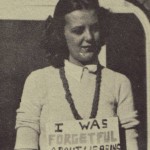

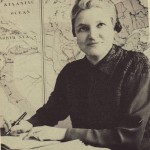












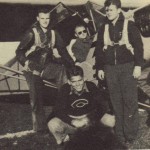

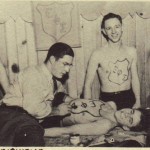
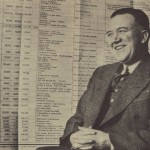
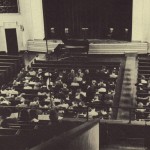



























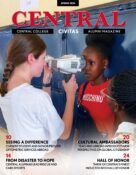
To encourage serious, intellectual discourse on Civitas, please include your first and last name when commenting. Anonymous comments will be removed.
Rachel Vogel Quinn
|
5:43 pm on May 29, 2013
Marvin and Juli, thank you both for your comments. The caption of the photo has been changed to reflect what you’ve told us. We rely on alumni knowledge about an era we don’t have detailed information about 70 years later. Please don’t hesitate to let us know about anything else from the 1940s!
Marvin Baker
|
12:23 pm on May 29, 2013
One of the pictures of the Flight School before and duringWWII states that Ray Doorenbos and Earl Pohlman were flight instructors is incorrect. Ray Doorenbos was a Ground
Instructor as I was. the widow of Ray Doorenbos still resides in Pella.
Pingback: The Greatest Generation at Central – Central College
Juli Pohlmann Roseburrough
|
5:20 pm on May 23, 2013
I just want to comment on one picture. It is the picture that states that Ray Doorenbos is giving last minute instructions to the Navy cadets. The man who is second from the right is my father, Earl Pohlmann, who was also a flight instructor for the Navy. I’m not clear on who has been identified at Ray Doorenbos but if it’s the man second from the right, that is incorrect as that is Earl Pohlmann. Love looking at the old pictures!